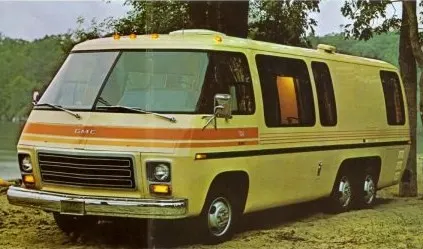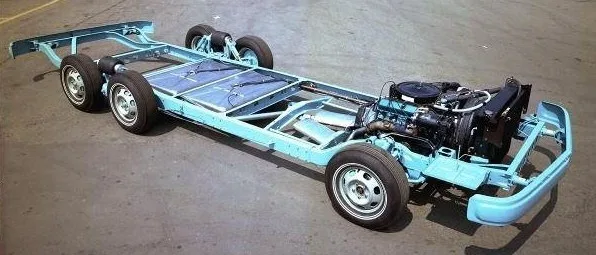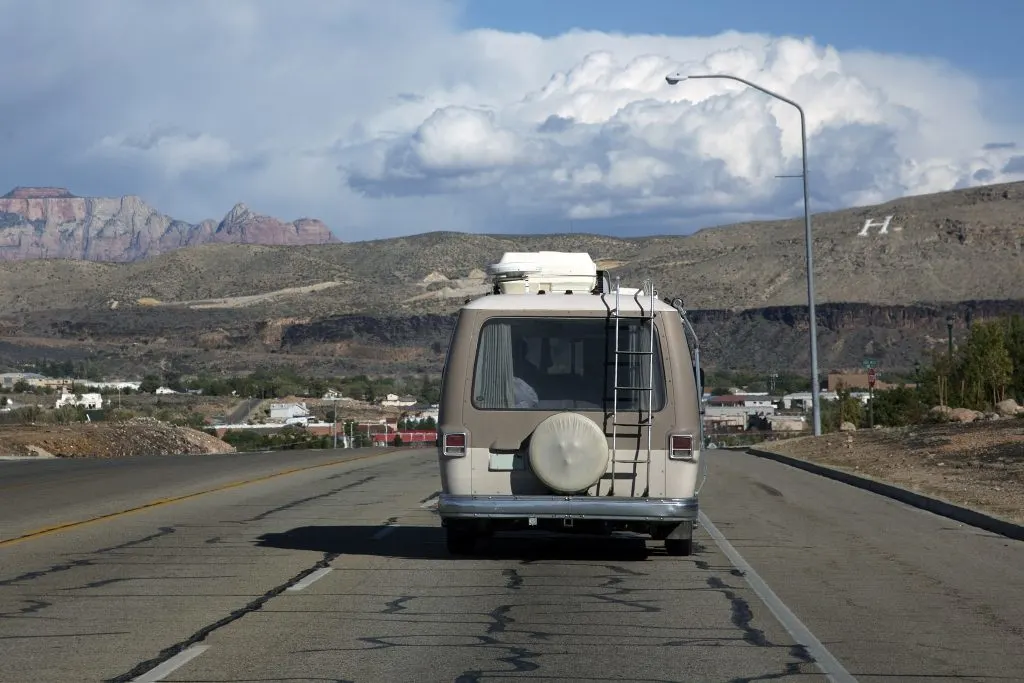If you’ve ever dreamt of cruising down the highway in a vehicle that screams both “I’m stuck in the ’70s” and “I have impeccable taste,” then the GMC Motorhome might just be your spirit animal—on wheels.
I remember the first time I laid eyes on one of these retro marvels. It was parked at a campground, shining in all of its glory. I couldn’t help but feel a pang of nostalgia mixed with admiration for whoever was bold enough to keep this relic on the road. As someone who has spent a fair share of time tinkering with vintage campers—yes, I’m that person hoarding parts for a 16-foot Fiber Stream in my garage—I felt an immediate kinship.
So, buckle up as we dive into the history, design, and lasting legacy of the GMC Motorhome—a classic American RV that refused to fade into obscurity.
History of the GMC Motorhome
The GMC Motorhome wasn’t just another boxy camper thrown together to capitalize on America’s post-war love affair with the open road.

No, this was General Motors swinging for the fences, aiming to redefine what a motorhome could be. I
ntroduced in 1972 at the Transpro ’72 show in Washington, D.C., and produced until 1978, the GMC Motorhome was a revolutionary leap in RV design—a self-contained, front-wheel-drive utopia for road enthusiasts who wanted to bring a slice of modern living with them.
Timing Wasn’t Ideal for the GMC Motorhome (But They Made It Work)
Let’s set the scene: the early 1970s. The Vietnam War was winding down, disco was gearing up to assault our ears, and the U.S. economy was about as stable as a unicyclist on ice. Not exactly the ideal time to launch a luxury motorhome that cost more than a modest house in the suburbs.
In 1973, the OPEC oil embargo sent fuel prices skyrocketing, leading to gas shortages and long lines at the pump.
Suddenly, driving a 26-foot motorhome that guzzled fuel like a frat boy at a keg party wasn’t the most financially savvy move. The Motorhome’s 455 cubic inch (7.5L) V8 engine, sourced from the Oldsmobile Toronado, was powerful but hardly fuel-efficient.
But GMC had already sunk millions into development, and pulling the plug wasn’t an option. So they pushed forward, banking on the Motorhome’s unique features to carve out a niche market. They marketed it as the “Only Motorhome Built by a Major Automaker,” emphasizing quality, durability, and innovation.
Despite the economic turmoil, a dedicated segment of the population was still enticed by the open road’s allure. The Motorhome offered a level of luxury and engineering that made it a compelling option for those willing to invest in adventure—even if it meant taking a financial leap of faith during uncertain times.
The Demise of the GMC Motorhome
Despite its innovative design and a cult following that would make indie bands jealous, the GMC Motorhome’s production run was short-lived. By 1978, economic pressures and shifting corporate priorities led General Motors to halt production. The economic downturn, coupled with new emissions regulations and increased competition, made the Motorhome less profitable.

Additionally, GM faced internal challenges. The company was grappling with quality control issues across various divisions and decided to refocus on its core automotive products. The Motorhome division, while innovative, was a small player in GM’s vast portfolio and became an easy target for cost-cutting measures.
It’s a classic tale of corporate short-sightedness. The GMC Motorhome was ahead of its time, offering features that wouldn’t become standard in RVs until decades later.
But alas, timing is everything, and the Motorhome became a casualty of economic downturns and corporate belt-tightening.
Design and Functionality
If there’s one thing the GMC Motorhome wasn’t, it’s ordinary. From its aerodynamic body to its automotive engineering, it was a rolling showcase of innovation.
Front-Wheel Drive and Low Profile
One of the most groundbreaking features was its front-wheel-drive system, borrowed from the Oldsmobile Toronado and Cadillac Eldorado.
This allowed for a flat floor throughout the interior, maximizing living space—a big deal when you’re trying to fit a kitchen, bathroom, and sleeping quarters into a tube on wheels. The low center of gravity and even weight distribution improved aerodynamics and handling, making it less like piloting a sailboat during a hurricane.
Aluminum and Fiberglass Construction
The body was made of aluminum and molded fiberglass-reinforced plastic, materials more commonly associated with sports cars and boats than RVs. The use of these lightweight materials reduced overall weight and prevented the dreaded rust plague that afflicted so many vehicles of the era.
Plus, it gave the Motorhome that sleek, spaceship-on-wheels look that turns heads even today.
Air Suspension
The GMC Motorhome featured a fully independent swing-arm air suspension system in the rear, borrowed from their city bus designs. This wasn’t just for bragging rights; it provided a smoother ride and allowed the vehicle to “kneel” for easier entry and exit.
The air suspension could adjust to road conditions, offering a level of comfort unheard of in other motorhomes at the time.
Power and Performance
Under the hood, the early models came with the 455 Oldsmobile Rocket engine, while later models switched to a 403 cubic inch (6.6L) engine due to emissions regulations. Coupled with a Turbo-Hydramatic 425 automatic transmission, the Motorhome had the power to tackle highways and hills with relative ease.
For a vehicle its size, acceleration and handling were surprisingly responsive.

Interior Luxuries
Inside, the Motorhome was nothing short of a mid-century modern apartment. Options included an onboard 6 kW generator, air conditioning, a full kitchen with a three-burner stove, refrigerator, and even a bathroom with a shower. The layouts were customizable, catering to families, couples, or anyone who fancied a mobile bachelor pad.
The seating and sleeping arrangements were versatile.
Depending on the configuration, the Motorhome could sleep up to six people. The use of high-quality materials and finishes gave the interior a sense of luxury that was rare in RVs of the time.
Driver Experience
Behind the wheel, drivers reported an experience more akin to driving a large van than a cumbersome RV. The panoramic windshield provided excellent visibility, and the responsive handling was a pleasant surprise for a vehicle of its size.
The power steering and power brakes, standard features, made maneuvering less of a chore.
As someone who’s wrestled with the steering wheel of vintage campers that handle like a drunken elephant, I can appreciate the engineering feats that went into making the GMC Motorhome a joy to drive.

How Many GMC Motorhomes Were Made?
During its brief production run from 1973 to 1978, approximately 12,921 GMC Motorhomes were built. That’s a relatively small number when you consider the mass-production capabilities of General Motors.
But what they lacked in quantity, they made up for in impact.
Model Years and Variations
- 1973: The first models rolled out with the 455 V8 engine. Initial production faced some teething problems, as is common with new models, but these were quickly addressed.
- 1975: Midway through the production run, GM made improvements to the interior and exterior, offering new color schemes and options.
- 1977-1978: Due to stricter emissions standards, the engine was downgraded to the 403 V8. While it offered better fuel economy, it lacked some of the punch of its predecessor.
The models came in two lengths: 23 feet and 26 feet. They were designated by their length and floor plan, with names like “Canyon Lands,” “Glacier,” “Eleganza,” and “Palm Beach.” Each model had its own unique features and decor themes, appealing to a range of tastes.
Limited Editions and Special Models
There were also some limited-edition models, such as the “Royale” by Coachmen and the “Birchaven” model, which featured a rear door—a rarity in motorhome design. These special editions are highly sought after by collectors today.
Can You Still Find Working GMC Motorhomes Today?
Absolutely, and not only can you find them, but there’s also a passionate community dedicated to preserving and restoring these vintage beauties. Thanks to their durable construction and the availability of replacement parts—many of which are still being manufactured or can be retrofitted—GMC Motorhomes have enjoyed a longevity that few vehicles from the ’70s can boast.
Online Communities and Clubs
There are numerous clubs and online forums where owners share tips, resources, and stories. Websites like GMCmotorhome.org, the GMC Motorhome Marketplace, and various Facebook groups have become hubs for enthusiasts. They trade everything from mechanical advice to rare parts, keeping the legacy alive.
Organizations like the GMC Motorhomes International (GMCMI) host rallies and events, providing opportunities for owners to meet, showcase their motorhomes, and share their passion. It’s a tight-knit community that welcomes newcomers with open arms and a toolbox at the ready.
Restoration and Modernization
Some owners choose to restore their GMC Motorhomes to their original glory, right down to the avocado green appliances and shag carpeting. Others opt to modernize the interiors with contemporary amenities while preserving the classic exterior. Solar panels, LED lighting, and state-of-the-art entertainment systems have found their way into these vintage shells, bridging the gap between past and present.
Restoration shops specializing in GMC Motorhomes have sprung up across the country. Companies like Cooperative Motor Works in Florida and Cinnabar Engineering in Michigan offer services ranging from mechanical repairs to full restorations.
Market Value
As with any classic vehicle, the value of a GMC Motorhome varies based on condition, originality, and the level of restoration.
Prices can range from under $10,000 for a fixer-upper to over $100,000 for a fully restored, modernized model. Considering the cost of new motorhomes that lack the character and history of a GMC, many see this as a worthwhile investment.
PRO TIP: Our Favorite 5 Small Class A RVs in the USA
My Own Encounter
I had the chance to tour a meticulously restored 1976 Eleganza II at a vintage RV rally. Stepping inside was like entering a time capsule—wood paneling, plush upholstery, and all the chrome accents you could desire.
The owner, a retired engineer named Bill, had installed modern conveniences like a flat-screen TV, a high-efficiency HVAC system, and a custom sound system, but had kept the original layout intact.
Bill regaled me with tales of his cross-country adventures, the challenges of finding parts in the pre-internet days, and the joy of driving a vehicle that sparks conversations wherever he goes. His enthusiasm was infectious, and I found myself considering the logistics of adding a GMC Motorhome to my collection—a dangerous line of thought for someone with limited driveway space and an understanding spouse.
The Classic GMC Motorhome Summed Up
The GMC Motorhome is more than just an old RV; it’s a symbol of a bygone era when design and innovation took precedence over cost-cutting and market trends. It’s a testament to what can happen when a company dares to think outside the box—or, in this case, the rectangle on wheels.
In a world where most motorhomes look like oversized toasters, the GMC stands out with its timeless design and forward-thinking features. It’s no wonder that decades after the last one rolled off the assembly line, these vehicles are still turning heads and capturing hearts.
For me, the allure lies not just in the vehicle itself but in the stories it carries—the families who’ve made memories on road trips, the enthusiasts who’ve poured countless hours into restoration, and the community that rallies around keeping this piece of automotive history alive.
So, can you still find working GMC Motorhomes today? Yes, and they’re not just museum pieces. They’re out there on the open road, carrying on the legacy of a time when the journey was just as important as the destination. And who knows? Maybe one day I’ll trade in my trusty Fiber Stream for one of these classics. After all, life is too short to drive boring vehicles.
If you ever find yourself behind the wheel of a GMC Motorhome, cruising down Route 66 with the wind in your hair and the rumble of that V8 engine as your soundtrack, you’ll understand why this classic American RV continues to captivate the hearts and minds of adventurers and nostalgists alike. It’s not just a motorhome; it’s a rolling piece of art, engineering, and history—a true testament to American ingenuity.
We’ll Help You Find the Best Free Camping in the USA
You should give it a try!
As a matter of fact, these free campsites are yours to enjoy. Every time you pay federal taxes, you’re contributing to these lands.
Become a FREE CAMPING INSIDER and join the 100,000 campers who love to score the best site!
We’ll send you the 50 Best Free Campsites in the USA (one per state). Access the list by submitting your email below:
If you would like a somewhat more detailed look into the history of the GMC motorhomes, visit this link.
https://automotivetraveler.com/magazine/viewer.php?path=2011/04/GMC_Motorhomes&page=1
I’ve owned a 26-foot GMC motorhome and a 29-foot FMC 2900R, currently. I can tell you from experience that as a single-wide, 1970s premium motorhome, there is no comparison. The FMC is better in almost every measurable way.
Here’s an inside look at mine.
https://www.youtube.com/watch?v=GDjcQy3SZmc&t=56s
First, the extra three feet makes all the difference in the livability sweepstakes. Second, in so many ways, the FMCs are better engineered and better built than their GMC counterparts.
If you want to know more, let me know in the comments.
To the Drivin’ & Vibin’ team, if you read this, if you want me to do something for you on the FMC motorhomes, send me a private message.